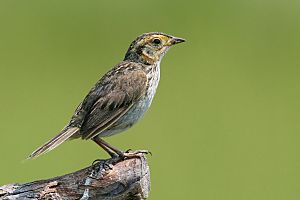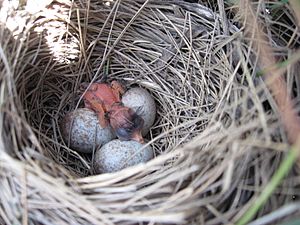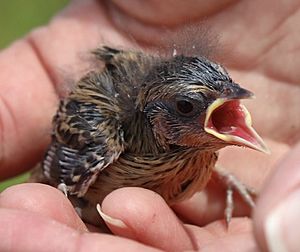Saltmarsh sparrow facts for kids
Quick facts for kids Saltmarsh sparrow |
|
|---|---|
 |
|
| Conservation status | |
| Scientific classification | |
| Genus: |
Ammospiza
|
| Species: |
caudacuta
|
 |
|
The saltmarsh sparrow (Ammospiza caudacuta) is a small bird found in salt marshes along the Atlantic coast of the United States. These birds live in salty wetlands. Long ago, people thought this bird and the Nelson's sparrow were the same species. Because of this, it was briefly called the "saltmarsh sharp-tailed sparrow."
Sadly, the number of saltmarsh sparrows is going down. This is mostly because their homes are being lost due to human activities.
Contents
About the Saltmarsh Sparrow
The saltmarsh sparrow is a small bird, about 11 to 14 centimeters (4.3 to 5.5 inches) long. Its wings can spread 17.8 to 21 centimeters (7 to 8.3 inches) wide. It weighs between 14 and 23.1 grams (0.5 to 0.8 ounces), which is about as much as a few quarters.
Adult saltmarsh sparrows have brown feathers on their backs. Their neck area, called the nape, is gray. Their throat and belly are white. Their chest and sides are a pale orange with brown streaks. Their face is orange with gray cheeks. They have a gray stripe on top of their head and brown stripes near their eyes. Their tail feathers are short and pointy.
It can be tricky to tell this bird apart from its close relatives, like the Nelson's sparrow. The Nelson's sparrow usually has lighter streaks and brighter orange on its chest. The saltmarsh sparrow also has a slightly longer beak.
Saltmarsh Sparrow Family Tree
The name caudacuta comes from Latin and means "sharp-tailed," which describes its pointy tail feathers. The saltmarsh sparrow's closest relatives are the Nelson's sparrow (Ammospiza nelsoni) and the Seaside sparrow (Ammospiza maritima).
The saltmarsh sparrow and the Nelson's sparrow were once considered the same species. Scientists now believe they split into two different species about 600,000 years ago. This likely happened during an ice age, which separated their ancestors into groups living inland and groups living near the coast. The inland Nelson's sparrow learned to live in freshwater wetlands, while the coastal saltmarsh sparrow became a specialist of salty tidal marshes. Today, the Nelson's sparrow has started to move into coastal salt marshes, and sometimes the two species breed together where their homes overlap.
There are two types, or subspecies, of the saltmarsh sparrow. The northern type, A. caudacutus caudacutus, lives and has its babies from Maine to New Jersey. The southern type, A. caudacutus diversus, lives and has its babies in Maryland and Virginia. The southern type has more noticeable stripes on its back and a darker head than the northern type.
Where Saltmarsh Sparrows Live
The saltmarsh sparrow lives only in tidal salt marshes along the Atlantic coast of the United States. These are wetlands that are regularly flooded by ocean tides. They have their babies along the northern coast, from Maine down to the Chesapeake Bay. In winter, they fly south to warmer areas, from North Carolina to Florida.
Saltmarsh sparrows prefer the "high marsh" areas. These areas are mostly covered by plants like Saltmeadow cordgrass (Spartina patens) and saltmarsh rush (Juncus gerardii). High marsh areas do not flood as often as "low marsh" areas, making them safer for nests.
Saltmarsh Sparrow Behavior
Vocalizations
Only the male saltmarsh sparrows sing. Their song is a quiet mix of buzzing, trilling, and gurgling sounds. It's different from the Nelson's sparrow's song, which is louder and sounds like a hissing buzz. However, the short, high-pitched calls they use to keep in touch with each other sound very similar for both species.
Diet
Saltmarsh sparrows look for food on the ground, near tidal channels, or in marsh plants. Sometimes, when the tide is low, they poke their beaks into the mud to find food. More than 80% of what they eat includes flies, small shrimp-like creatures called amphipods, grasshoppers, and moths. They especially like soldier flies at all stages of their life. In the winter, they also eat seeds. Saltmarsh sparrows are not picky eaters, and they usually find plenty of food.
Reproduction and Life Cycle
Saltmarsh sparrows don't defend specific territories. Instead, they have large areas where they roam, and these areas often overlap with other sparrows. Male sparrows' roaming areas can be twice as big as females', sometimes covering an area as large as 50 hectares (124 acres).
During the nesting season, male sparrows fly long distances, chasing females. Only the female sparrow takes care of the babies. She builds the nest, sits on the eggs to keep them warm, and brings food to the young birds. The nest is shaped like an open cup and is made of grass. It's usually attached to plants like Saltmeadow cordgrass or saltmarsh rush, about 6 to 15 centimeters (2.4 to 5.9 inches) off the ground. A female usually lays 3 to 5 eggs. She starts sitting on the eggs after the last one is laid, and they hatch in 11 to 12 days. The young birds leave the nest 8 to 11 days after hatching, but they still need their mother to feed them for another 15 to 20 days.
The biggest danger to saltmarsh sparrow nests is flooding. This happens during big storms or very high tides, which occur about every 28 days during the new moon. Saltmarsh sparrows have learned ways to deal with floods. They can fix their nests, move their eggs to safety, build new nests quickly if one is lost, and time their breeding with the moon's cycle. They start nesting right after a high tide, so their young can grow big enough to fly before the next high tide. They usually raise two groups of babies each breeding season.
Protecting the Saltmarsh Sparrow
The saltmarsh sparrow is a bird that needs a lot of help. Its population is shrinking because its habitat is being lost, leaving only small, separated groups of birds. Salt marshes are among the most threatened habitats in the world. They are naturally limited in size, have been changed by humans for a long time, and are now threatened by rising sea levels. The spread of an invasive plant called Phragmites also takes away their living space.
Saltmarsh sparrows are very sensitive to rising sea levels because floods are a major cause of nest loss. Also, these birds can get a lot of mercury in their bodies, which is a type of pollution, but scientists are still studying how this affects their survival.
Between the 1990s and 2010s, the number of saltmarsh sparrows dropped by 5% to 9% each year. This means their total population has gone down by more than 75%. If nothing changes, scientists believe the saltmarsh sparrow could disappear by 2050. In 2016, the saltmarsh sparrow was put on the "State of North America's Birds Watch List" because it is in so much trouble. The United States Fish and Wildlife Service is currently looking into whether the bird should be protected under the Endangered Species Act. In 2016, there were an estimated 53,000 saltmarsh sparrows left.
See also
 In Spanish: Ammodramus caudacutus para niños
In Spanish: Ammodramus caudacutus para niños




